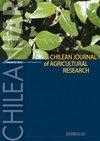Castillo el Tambo’咖啡植物以生物炭和化学肥料施用
IF 1.8
4区 农林科学
Q2 AGRICULTURE, MULTIDISCIPLINARY
引用次数: 0
摘要
目前化肥成本上升,有必要评估互补的农艺策略。生物炭(BC)以相对较低的成本提供了几个潜在的好处。本试验旨在研究4种不同剂量生物炭(BC)(0、4、8和16 t hm -1)和4种施肥水平(FL)(营养需要量的0%、33%、66%和100%)的施用效果。我们从咖啡(Coffea arabica L.)果肉中获得了BC。选取的响应变量为:咖啡本文章由计算机程序翻译,如有差异,请以英文原文为准。
Physiological response of ‘Castillo el Tambo’ coffee plants to biochar and chemical fertilization applications
The fertilizers costs are currently elevated, and it is necessary to evaluate complementary agronomic strategies. Biochar (BC) offers several potential benefits at a relatively low cost. The research aimed was to study the effect of the application of four different doses of biochar (BC) (0, 4, 8, and 16 t ha-1) and four fertilization levels (FL) (0%, 33%, 66% and 100% of the nutritional requirements). We obtained the BC from coffee (Coffea arabica L.) pulp. The selected response variables were: Stomatal conductance (gs), water use efficiency (WUE), root hydraulic conductivity (K), leaf photosynthetic pigments (Chl), and total dry weight (TDW) of coffee âCastillo el Tamboâ. The experiment was conducted under greenhouse conditions. The results showed that plants with 0 t ha-1 and 0% FL registered low values in the physiological parameters evaluated (gs = 60.5 mmol m-2 s-1; WUE = 3.03 g DM L-1 H2O; Chl = 59.4 atLEAF readings; Kr = 9.7Ã10-6 kg s-1 MPa-1; TDW = 9.7 g). On the other hand, we recorded a positive effect when âCastillo el Tamboâ coffee plants received 8 t ha-1 BC (Kr = 11.8Ã10-6 kg s-1 MPa-1), especially at fertilization levels of 66% and 100% (gs = 146.7 and 167.5 mmol m-2 s-1; Chl = 72.8 and 66.6 Chl content; WUE = 4.3 and 5.0 g DM L-1 H2O; TDW = 13.6 and 16.0 g, respectively). In conclusion, the use of BC manufactured with coffee pulp, mainly at a dose of 8 t ha-1, can be an alternative to complement the chemical nutrition of coffee plants.
求助全文
通过发布文献求助,成功后即可免费获取论文全文。
去求助
来源期刊

Chilean Journal of Agricultural Research
AGRICULTURE, MULTIDISCIPLINARY-AGRONOMY
CiteScore
3.10
自引率
11.80%
发文量
60
审稿时长
6-12 weeks
期刊介绍:
ChileanJAR publishes original Research Articles, Scientific Notes and Reviews of agriculture, multidisciplinary and agronomy: plant production, plant protection, genetic resources and biotechnology, water management, soil sciences, environment, agricultural economics, and animal production (focused in ruminant feeding). The editorial process is a double-blind peer reviewing, Editorial Office checks format, composition, and completeness, which is a requirement to continue the editorial process. Editorial Committee and Reviewers evaluate relevance and scientific merit of manuscript.
 求助内容:
求助内容: 应助结果提醒方式:
应助结果提醒方式:


